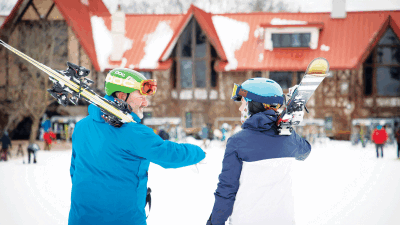BRIDGE MICHIGAN — Michigan’s outdoor recreation sector continued on a trajectory of rapid growth last year, prompting calls for greater investment in the land, water and infrastructure that underpins the industry.
New statistics from the U.S. Bureau of Economic Analysis show the sector grew by 11.8 percent in 2022, the second straight year of double-digit growth triggered by a global pandemic that pushed people outside and inspired them to purchase RVs, bicycles, kayaks and pack state parks to the gills.
“Positive continued opportunity is the key phrase,” said Brad Garmon, executive director of the state Outdoor Recreation Industry Office. “This is an opportunity, I think, that we can continue to invest in.”
“COVID was a game changer, in terms of people wanting to get outside and especially wanting to get outside and winter,” said Chris MacInnes, an owner of Crystal Mountain Resort in Benzie County.
The resort saw year-round participation growth over the past couple of years, MacInnes said, but especially during ski season.
Those stats are “mostly exciting,” said Jonathan Jarosz, executive director of the statewide land conservation group Heart of the Lakes, with a notable caveat: In an era of nationwide growth, Michigan’s performance was middling compared to other Great Lakes states, despite the fact that it contains more coastline and a higher percentage of public land than its neighbors.
“We’ve got all the stuff, and we still run midpack,” Jarosz said.
That’s consistent with broader concerns about Michigan’s long-term economic well being. The state ranks 49th nationally in population growth, falling behindall of its neighbors. Some blame that trend, in part, on stale economic development strategies that for generations have revolved around the automotive industry.
“We don't yet have a vision for what other industries look like,” Jarosz said.
Although the state clearly sees the outdoors as a marketing asset as it attempts to lure young professionals to Michigan, it continues to devote most economic development dollars to automotive manufacturers that have a history of polluting the state’s natural resources.
If Michigan wants the outdoor industry to keep growing once the pandemic boost wears off, Jarosz said, its embrace of the sector “has got to be more than gorpcore” — the fashion trend of outerwear as streetwear.
That includes spending more money to expand the state’s bicycle rim-makers,fishing line manufacturers and the like, while protecting the natural resources that underpin the industry.
Michigan historically has often done the opposite, sacrificing its natural resources to industry. Dan Cooke of Milford watched his friends move to other states because, he said, “they didn’t feel they could live a full outdoor lifestyle here.”
Cooke, whose company Expedition Detroit is focused on introducing people to the region’s outdoor amenities, said he sees that changing nowadays. Look no further than the Gordie Howe Bridge, which will include a bike and pedestrian path linking Michigan’s expanding trail network to Canada’s, or the revitalization of the Detroit River.
“Our culture has turned a corner,” Cooke said.
Garmon, the state outdoor industry czar, celebrated the numbers while noting that Michigan’s outdoor sector may face headwinds in the coming year.
Some companies overestimated just how much the pandemic would increase demand for outdoor goods, he said. And Wolverine Worldwide, one of Michigan’s largest outdoor manufacturers, is weathering stock losses and layoffs while holding massive financial liability for polluting West Michigan.
“We expect the 2023 data will not be quite as robust,” Garmon said.
Long term, he said, the industry’s success will hinge upon not just buying fishing reels, RVs, tents and the like, but “actually making more of it” in Michigan.
 Publication select ▼
Publication select ▼
























